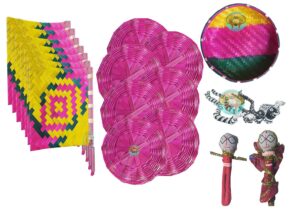Mithila (मिथिला, mithilā![]() was a kingdom in ancient Nepal and India. It existed in the eastern Gangetic plains in areas which is today spread over more than half of Bihar state of India, and parts of adjoining Nepal. Mithila was the capital of Videha Kingdom as per epic Ramayana. This city is identified as modern day Janakpur in Dhanusa district of Nepal. The country of Videha is sometimes referred as Mithila though it was the capital city, much the same way as Kosala Kingdom is referred as Ayodhya though Ayodhya was the capital of Kosala kingdom.
was a kingdom in ancient Nepal and India. It existed in the eastern Gangetic plains in areas which is today spread over more than half of Bihar state of India, and parts of adjoining Nepal. Mithila was the capital of Videha Kingdom as per epic Ramayana. This city is identified as modern day Janakpur in Dhanusa district of Nepal. The country of Videha is sometimes referred as Mithila though it was the capital city, much the same way as Kosala Kingdom is referred as Ayodhya though Ayodhya was the capital of Kosala kingdom.
The legend of Mithila extends over many centuries. Both Gautama Buddha and Vardamana Mahavira are said to have lived in Mithila. It also formed the center of Indian history during the first millennium, and has contributed to various literary and scriptural works.
The name Mithila is derived after Mythical King ‘Miti’. He was supposed to have been created from body of his father King Nimi. He established the capital of his kingdom at Mithilapuri and hence the region came to be called Mithila. Since he was born out of body of his father, he took the title Janaka. After this, the Kings of Mithila were called Janaka. The most famous Janaka was Kushadhwaja, father of Sita. He was 21st Janaka of Mithila. This Dynasty was also called Videha Janaka. There were 57 kings in the dynasty of Videha Janaka.
Ancient History and Myths
The most important reference to Mithila is in the Hindu epic, Ramayana where Lord Rama’s wife Sita is said to have been the princess of the land, born to King Janaka, who ruled Mithila from Janakpur. Other famous kings of Mithila during ancient period are King Bhanumath, Satghumanya, Suchi, Urjnama, Satdhwya, Kriti, Anjan, Arisnami, Srutayu, Supasyu, Suryasu, Srinjay, Sourmabi, Anena, Bhimrath, Satyarath, Upangu, Upgupt, Swagat, Snanand, Subrachya, Supraswa, Subhasn, Suchurut, Susurath, Jay, Vijay, Critu, Suny, Vith Habya, Dwati, Bahulaswa, Kriti Tirtiya.
It is said that the last King of Janak Dynasty was of bad character. He was dethroned by public under leadership of Acharyas (Learned Men). Thereafter, Mithila remained without King for hundreds of years. Instead of King, a democratic system was followed were the ruler was elected by the people and the decisions were taken in a collective manner. In fact, Mithila can be said to be the first democracy of the world. This continued for several centuries till the region was attacked and conquered by Maghadan Empire.
Thereafter several dynasties such as Vajjisangh, Lichhavis, Shaishunag, Nand, Maurya, Shung, Kant, Gupta, Vardhan etc. ruled there from time to time. There was no significant ruler in Mithila after Janaks till 5th–6th century when Jaywardhan Raja Salhesh became King. He made his capital at Mahisautha-Siraha (presently in Nepal). He defended the region against attacks by Tibetans several times. Hence, he was called Shailesh (king of Mountains) from Jaywardhan which in local dialect was called Salhesh.
Produced by MithilanchalGroup

